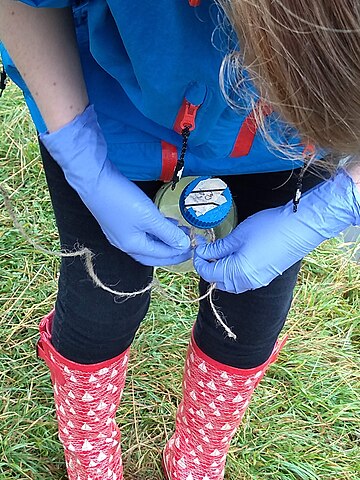Hans Bethe Updated 2025-07-16
Richard Feynman was working under him there, and was promoted to team lead by him because Richard impressed Hans.
He was also the person under which Freeman Dyson was originally under when he moved from the United Kingdom to the United States.
And Hans also impressed Feynman, both were problem solvers, and liked solving mental arithmetic and numerical analysis.
This relationship is what brought Feynman to Cornell University after World War II, Hans' institution, which is where Feynman did the main part of his Nobel prize winning work on quantum electrodynamics.
Hans Petter Langtangen Updated 2025-07-16
GitHub account: github.com/hplgit
It should be mentioned that when you start Googling for PDE stuff, you will reach Han's writings a lot under his GitHub Pages: hplgit.github.io/, and he is one of the main authors of the FEniCS Project.
He also published to GitHub pages with his own crazy markdown-like multi-output markup language: github.com/hplgit/doconce.
Rest in peace, Hans.
Harvard University Updated 2025-07-16
How to decide if an ORM is good? Updated 2025-07-16
How to decide if an ORM is decent? Just try to replicate every SQL query from nodejs/sequelize/raw/many_to_many.js on PostgreSQL and SQLite.
There is only a very finite number of possible reasonable queries on a two table many to many relationship with a join table. A decent ORM has to be able to do them all.
If it can do all those queries, then the ORM can actually do a good subset of SQL and is decent. If not, it can't, and this will make you suffer. E.g. Sequelize v5 is such an ORM that makes you suffer.
The next thing to check are transactions.
Basically, all of those come up if you try to implement a blog hello world world such as gothinkster/realworld correctly, i.e. without unnecessary inefficiencies due to your ORM on top of underlying SQL, and dealing with concurrency.
How to diagnose a genius by Wilhelm Ostwald (1909) Updated 2025-07-16
From the abstract:Ciro Santilli couldn't agree more... notably students must have a flexible choice of what to learn.
Much money, his student went on to say, is spent by various Governments in attempting to discover those people whose thorough education may be expected to bring in a return of value to the State, and the question how best to discover latent genius is an eminently practical one. After cogitation, Prof. Ostwald came to the conclusion that it is those students who cannot be kept on the rails - that is, who are not contented with methodical teaching - who have within them the seeds of genius
How to exit from repl in rshell? Updated 2025-07-16
Ctrl + X. Documented by running
help repl from the main shell. How to make animations of molecular biology processes Updated 2025-07-16
How to use an Oxford Nanopore MinION to extract DNA from river water and determine which bacteria live in it PCR Updated 2025-07-16
More generic PCR information at: Section "Polymerase chain reaction".
Because it is considered the less interesting step, and because it takes quite some time, this step was done by the event organizers between the two event days, so participants did not get to take many photos.
PCR protocols are very standard it seems, all that biologists need to know to reproduce is the time and temperature of each step.
This process used a Marshal Scientific MJ Research PTC-200 Thermal Cycler:
We added PCR primers for regions that surround the 16S DNA. The primers are just bought from a vendor, and we used well known regions are called 27F and 1492R. Here is a paper that analyzes other choices: academic.oup.com/femsle/article/221/2/299/630719 (archive) "Evaluation of primers and PCR conditions for the analysis of 16S rRNA genes from a natural environment" by Yuichi Hongoh, Hiroe Yuzawa, Moriya Ohkuma, Toshiaki Kudo (2003)
One cool thing about the PCR is that we can also add a known barcode at the end of each primer as shown at Code 1. "PCR diagram".
This means that we bought a few different versions of our 27F/1492R primers, each with a different small DNA tag attached directly to them in addition to the matching sequence.
This way, we were able to:
- use a different barcode for samples collected from different locations. This means we
- did PCR separately for each one of them
- for each PCR run, used a different set of primers, each with a different tag
- the primer is still able to attach, and then the tag just gets amplified with the rest of everything!
- sequence them all in one go
- then just from the sequencing output the barcode to determine where each sequence came from!
Input: Bacterial DNA (a little bit)
... --- 27S --- 16S --- 1492R --- ...
|||
|||
vvv
Output: PCR output (a lot of)
Barcode --- 27S --- 16S --- 1492RCode 1.
PCR diagram
. Finally, after purification, we used the Qiagen QIAquick PCR Purification Kit protocol to purify the generated from unwanted PCR byproducts.
How to run a MicroPython script from a file on the Raspberry Pi Pico W from the command line? Updated 2025-07-26
The first/only way Ciro could find was with ampy: stackoverflow.com/questions/74150782/how-to-run-a-micropython-host-script-file-on-the-raspbery-pi-pico-from-the-host/74150783#74150783 That just worked and it worked perfectly!
pipx install adafruit-ampy
ampy --port /dev/ttyACM0 run blink.py How to show that a group is simple Updated 2025-07-16
scholarworks.sjsu.edu/cgi/viewcontent.cgi?referer=https://www.google.com/&httpsredir=1&article=5051&context=etd_theses proves that the Mathieu group is simple in just 200 pages. Nice.
How to teach Advertise your material Updated 2025-07-16
Once you have crated something awesome, you have to advertise it, otherwise no one will ever find it.
This means:
- Then ask them if they want to talk about anything.
- whenever someone asks as question on an online forum, answer it, and link to the section of your material that also answers that question.The material will answer many of their future questions.
Eventually, people will find you on the front page of Google searches, and then you will know that you've truly made something useful.
How to teach Become famous through teaching Updated 2025-07-16
How to use an Oxford Nanopore MinION to extract DNA from river water and determine which bacteria live in it Qiagen DNeasy PowerWater Kit Updated 2025-07-16
www.qiagen.com/gb/products/discovery-and-translational-research/dna-rna-purification/dna-purification/microbial-dna/dneasy-powerwater-kit (archive) Here is its documentation: www.qiagen.com/gb/resources/download.aspx?id=bb731482-874b-4241-8cf4-c15054e3a4bf&lang=en (archive).
How to use an Oxford Nanopore MinION to extract DNA from river water and determine which bacteria live in it Sample collection Updated 2025-07-16
As you would expect, not much secret here, we just dumped a 1 liter glass bottle with a rope attached around the neck in a few different locations of the river, and pulled it out with the rope.
How to use an Oxford Nanopore MinION to extract DNA from river water and determine which bacteria live in it Using the Oxford Nanopore Updated 2025-07-16
With all this ready, we opened the Nanopore flow cell, which is the 500 dollar consumable piece that goes in the sequencer.
We then had to pipette the final golden Eppendorf into the flow cell. My anxiety levels were going through the roof: Figure 4. "Oxford nanopore MinION flow cell pipette loading.".
At this point bio people start telling lab horror stories of expensive solutions being spilled and people having to recover them from fridge walls, or of how people threw away golden Eppendorfs and had to pick them out of trash bins with hundreds of others looking exactly the same etc. (but also how some discoveries were made like this). This reminded Ciro of: youtu.be/89UNPdNtOoE?t=919 Alfred Maddock's plutonium spill horror story.
Luckily this time, it worked out!
As can be seen from Video 1. "Oxford Nanopore MinION software channels pannel on Mac." the software tells us which pores are still working.
Pores go bad sooner or later randomly, until there are none left, at which point we can stop the process and throw the flow cell away.
48 hours was expected to be a reasonable time until all pores went bad, and so we called it a day, and waited for an email from the PuntSeq team telling us how things went.
We reached a yield of 16 billion base pairs out of the 30Gbp nominal maximum, which the bio people said was not bad.
How to teach Give examples Updated 2025-07-16
Keep the example/theory ratio high, very, very high.
How to teach Let students learn by teaching Updated 2025-07-16
Tell students to:
- make suggestions to the course material themselves, since you have used text and published your source.Review their suggestions, and accept the best ones.
- answer the questions of other students on your online forum. Let them work instead of you.
Praise those that do this very highly, and give them better grades if you have that superpower.
Whatever you do, even if it is playing video games: if you manage to produce related content that will interest other people, and possibly allow you to get paid, it will much much fun to do that thing.
How to teach Projcts must aim for novelty Updated 2025-07-16
How to teach Use the Internet Updated 2025-07-16
How to use a single source multiple times in a Wikipedia article? Updated 2025-07-16
en.wikipedia.org/wiki/Help:Footnotes#Footnotes:_using_a_source_more_than_once gives the following method:
Definition, anywhere on article, likely ideally as the first usage:
<ref name="myname">{{cite web ...}}</ref>And then you can use it later on as:which automatically expands the exact same thing, or using the shortcut:
<ref name="myname" />{{r|myname}}To cite multiple pages of a book: en.wikipedia.org/wiki/Wikipedia:Citing_sources#Citing_multiple_pages_of_the_same_source, the best method is to define and use the reference without adding the Do not set the page in or for multiple pages:
p or location in cite as:<ref name="googleStory">{{cite book |title=The Google Story}}</ref>{{rp|p=123}}cite, otherwise it shows up on the references. Instead we use the {{rp}} template. And then use the reference with the {{r}} template as:{{r|googleStory|p=456}}{{r|googleStory|pp=123, 156-158}} Unlisted articles are being shown, click here to show only listed articles.












